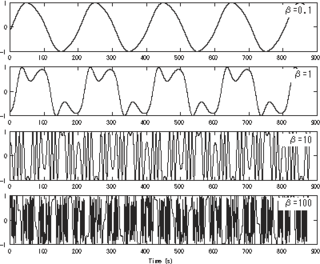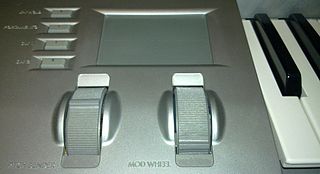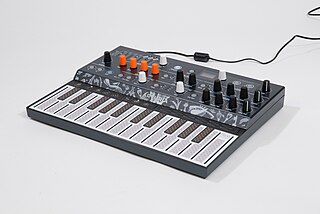This article possibly contains original research .(February 2024) |
Linear arithmetic synthesis, or LAsynthesis, is a means of sound synthesis invented by the Roland Corporation when they released their D-50 synthesizer in 1987. [1]
This article possibly contains original research .(February 2024) |
Linear arithmetic synthesis, or LAsynthesis, is a means of sound synthesis invented by the Roland Corporation when they released their D-50 synthesizer in 1987. [1]

LA synthesis combines traditional subtractive synthesis with PCM-based samples.
The term linear arithmetic refers to synthesis that puts sounds together in a timeline. Typically a PCM transient begins a note, which is then continued with a subtractive synthesis prolongation. Roland did not use the term additive, as additive synthesis already refers to a different synthesis method. [2]
This technology first appeared in 1987, in the Roland D-50 synthesizer. At the time, re-synthesizing samplers were very expensive, so Roland set out to produce a machine that would be easy to program, sound realistic, and still sound like a synthesizer. Also, Yamaha had previously gained world market lead with their DX7 FM synth, which excelled at metallic, percussive sounds—something that Roland's synths using subtractive synthesis were less good at.
Roland understood that their subtractive synthesis method had to change. One of the more complex parts of a sound to program is the attack transient, so Roland added a suite of sampled attack transients to subtractive synthesis. As well as the attack transients, Roland added a suite of single-cycle sampled waveforms that could be continuously looped. Sounds could now have three components: An attack, a body made from a subtractive synth sound (saw or pulse wave through a filter) and an "embellishment" of one of many looped samples. (The looped samples also contained a collection of totally synthetic waves derived from additive synthesis, as well as sequences of inharmonic wave cycles. Thus, LA synthesis offered the realistic sounds of a sampler with the control and creativity of a synthesizer.)
The PCM waveforms could be modified with a pitch envelope and a time-variant amplifier. Waveforms from the sound wave generators could be further modified with time-variant filters for cutoff frequency and resonance. These modified waveforms were called "partials".
Two partials grouped together created a tone. Tones could be modified using up to three low-frequency oscillators, a pitch envelope, a programmable equalizer, and on-board effects such as reverberation and chorus. Two tones grouped together created a patch.
Yamaha's SY77, its rack-mount equivalent TG77, and successor SY99 introduced Advanced Wave Memory 2 (AWM2), enabling playback and digital filtering of samples. Notably, these also let AWM2 samples be used as transients to Advanced FM (AFM) synth sounds, as looped oscillators in their own right, or even as modulators of AFM carriers. This, like LA, enabled more realistic modeling of physical instruments, and in combination with FM, new possibilities for synthesis. The SY99 seemed to be the last FM workstation by Yamaha, and the later FM synth FS1R did not feature AWM — so SY99 was seemingly the last synth in which AWM and FM could be combined. This was until the Montage in 2016, which combines a later version of AWM2 with FM-X (an offshoot of the FM engine from FS1R, without the latter's Formant Synthesis) - though without letting samples be used as modulators, as the 77/99 series did. In any case, AWM sampling on its own has become a mainstay of subsequent flagship Yamaha products, such as the Yamaha EX5, Motif, and Montage lines — which still use the umbrella term AWM2, though the engine's details have changed many times.
Casio has also developed a similar synthesis system known as Advanced and High Quality Large Waveform, better known as AHL, for use on their portable keyboard line. Earlier Casio keyboard models instead use ZPI, a similar but more advanced system. AHL was originally a simplified version of the previous ZPI, in which both are mostly optimized for acoustic instrument samples.
Ensoniq with the SQ-80 called the same technique Cross Wave Synthesis. Kawai with the K4 called the same technique Digital Multi Spectrum.
Korg's Modwave engine was designed to do both the morphing wavetable and sample synthesis, along with the usage of MS-20 filters due to its slope, which makes it closer to Roland's D-50 / D-550 / D-05 LA synthesizers. Some features are limited to layers instead of individual oscillators (e.g. filters).

A digital synthesizer is a synthesizer that uses digital signal processing (DSP) techniques to make musical sounds. This in contrast to older analog synthesizers, which produce music using analog electronics, and samplers, which play back digital recordings of acoustic, electric, or electronic instruments. Some digital synthesizers emulate analog synthesizers; others include sampling capability in addition to digital synthesis.

Frequency modulation synthesis is a form of sound synthesis whereby the frequency of a waveform is changed by modulating its frequency with a modulator. The (instantaneous) frequency of an oscillator is altered in accordance with the amplitude of a modulating signal.
Subtractive synthesis is a method of sound synthesis in which partials of an audio signal are attenuated by a filter to alter the timbre of the sound. While subtractive synthesis can be applied to any source audio signal, the sound most commonly associated with the technique is that of analog synthesizers of the 1960s and 1970s, in which the harmonics of simple waveforms such as sawtooth, pulse or square waves are attenuated with a voltage-controlled resonant low-pass filter. Many digital, virtual analog and software synthesizers use subtractive synthesis, sometimes in conjunction with other methods of sound synthesis.

An analog synthesizer is a synthesizer that uses analog circuits and analog signals to generate sound electronically.
Wavetable synthesis is a sound synthesis technique used to create quasi-periodic waveforms often used in the production of musical tones or notes.

The Roland D-50 is a synthesizer produced by Roland and released in April of 1987. It's features include digital sample-based subtractive synthesis, on-board effects, a joystick for data manipulation, and an analog synthesis-styled layout design. The external Roland PG-1000 (1987) programmer could also be attached to the D-50 for more complex manipulation of its sounds. It was also produced in a rack-mount variant design, the D-550, with almost 450 user-adjustable parameters.
A rompler is an electronic musical instrument that plays pre-fabricated sounds based on audio samples. The term rompler is a blend of the terms ROM and sampler. In contrast to samplers, romplers do not record audio. Both may have additional sound editing features, such as layering several waveforms and modulation with ADSR envelopes, filters and LFOs.
The Yamaha AN1x is a DSP-based analog modeling synthesizer, produced by Yamaha Corporation from 1997 to 1998, and was marketed as an "analog physical modelling control synthesizer".
Phase distortion (PD) synthesis is a synthesis method introduced in 1984 by Casio in its CZ range of synthesizers. In outline, it is similar to phase modulation synthesis as championed by Yamaha Corporation, in the sense that both methods dynamically change the harmonic content of a carrier waveform by influence of another waveform (modulator) in the time domain. However, the application and results of the two methods are quite distinct.

The Korg OASYS is a workstation synthesizer released in early 2005, 1 year after the successful Korg Triton Extreme. Unlike the Triton series, the OASYS uses a custom Linux operating system that was designed to be arbitrarily expandable via software updates, with its functionality limited only by the PC-like hardware.

The Korg DW-8000 synthesizer is an eight-voice polyphonic hybrid digital-analog synthesizer 61-note keyboard instrument released in 1985. By the time of its launch, Korg had already begun a common trend in 1980s synthesizer design: using numerical codes to access or change parameters with its predecessor - the Korg Poly-61, which was widely regarded as the company's first "knobless" synthesizer. This was a move away from the heavily laden, complex control panels of earlier designs.

The Korg Wavestation is a vector synthesis synthesizer first produced in the early 1990s and later re-released as a software synthesizer in 2004. Its primary innovation was Wave Sequencing, a method of multi-timbral sound generation in which different PCM waveform data are played successively, resulting in continuously evolving sounds. The Wavestation's "Advanced Vector Synthesis" sound architecture resembled early vector synths such as the Sequential Circuits Prophet VS.
The Yamaha SY85 is a digital music workstation introduced in 1992. Unlike other Yamaha synthesizers of the time the SY85 does not use FM synthesis. Instead, its sounds are based on samples, which can be layered and modified to create new sounds.

Yamaha TG77 is the rack-mounted equivalent of Yamaha Corporation's SY77 synthesizer workstation. It, too, is a 16-voice multitimbral music (synthesizer) utilizing Yamaha's Advanced Frequency Modulation; Advanced Wave Memory; and the combination of these two systems, either by layering together or by modulating an AFM voice by an AWM wave, a synergy termed Realtime Convolution and Modulation Synthesis (RCM). The unit came into production in 1989, simultaneously with the SY77.

Yamaha SY77 is a 16 voice multitimbral music workstation first produced by Yamaha Corporation in 1989. The SY77 is a synthesizer whose architecture combines AFM synthesis, AWM2 for ROM-borne sample-based synthesis, and the combination of these two methods christened Realtime Convolution and Modulation Synthesis (RCM). The same technology was also packaged in a rack-mounted module released simultaneously, the TG77.

A synthesizer is an electronic musical instrument that generates audio signals. Synthesizers typically create sounds by generating waveforms through methods including subtractive synthesis, additive synthesis and frequency modulation synthesis. These sounds may be altered by components such as filters, which cut or boost frequencies; envelopes, which control articulation, or how notes begin and end; and low-frequency oscillators, which modulate parameters such as pitch, volume, or filter characteristics affecting timbre. Synthesizers are typically played with keyboards or controlled by sequencers, software or other instruments and may be synchronized to other equipment via MIDI.
Casio's SDSynthesizers were a late-1980s line of analog synthesizers featuring a resonant filter. SD synthesis was traditional DCO-analog synthesis, with the main difference being that some of the SD waveforms' harmonic spectrums changed temporally, or dynamically in relation to the amplitude envelope.

The CZ series is a family of low-cost phase distortion synthesizers produced by Casio in the mid-1980s. Eight models of CZ synthesizers were released: the CZ-101, CZ-230S, CZ-1000, CZ-2000S, CZ-2600S, CZ-3000, CZ-5000, and the CZ-1. Additionally, the home-keyboard model CT-6500 used 48 phase distortion presets from the CZ line. The CZ synthesizers' price at the time of their introduction made programmable synthesizers affordable enough to be purchased by garage bands. Yamaha soon introduced their own low-cost digital synthesizers, including the DX-21 (1985) and Yamaha DX100, in light of the CZ series' success.

The Korg Z1 is a physical modelling sound synthesiser released in 1997. Touted as a polyphonic Prophecy, the Z1 implements 13 synthesis types, all derived from the original OASYS synthesizer.

The MicroFreak is a synthesizer manufactured by French music technology company Arturia and released in 2019. Described as a "Hybrid Experimental Synthesizer", it uses 18 digital sound engines (algorithms) to synthesize raw tones. This digital oscillator is then fed into a multi-mode analog filter, giving the MicroFreak its hybrid sounds.